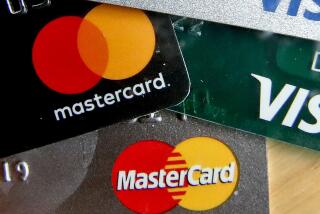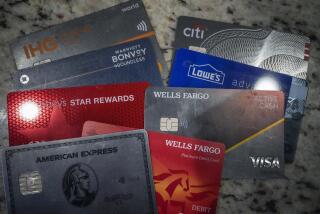More Americans Turning to Their Credit Cards to Purchase Groceries : Retailing: Consumer groups decry the trend, saying it drives up shoppers’ food costs. Card issuers say the practice offers convenience.
- Share via
With the nation’s unemployment level at 7.7% and the economy sputtering, there is growing concern that more Americans are turning to their credit cards to pay for essentials, including the weekly groceries.
Consumer advocates are alarmed at an explosion of credit card charges at supermarkets. The number of grocery stores accepting Visa and Mastercard jumped more than sixfold to 5,000 in the past year and total purchases are increasing at more than 50% a year.
“I think it’s totally inappropriate to use credit cards for food purchases,” said Ken McEldowney, director of Consumer Action in San Francisco. “When the financially strapped start to use credit cards for essentials, it’s a sign that they are about to go further into debt.”
Frances Smith, vice president of the Consumer Credit Education Foundation, an organization founded by a consumer finance trade group, agreed. She said many consumers end up paying more for food when they use charge cards.
“It’s never a good idea to use credit to purchase essentials,” she said.
But grocers and credit card issuers say allowing purchases to be charged at supermarkets offers consumers convenience, just like the time-saving service provided at other types of stores. They also say there is little evidence that card use at supermarkets has contributed significantly to a recent rise in credit card debt.
“It’s time-saving and convenient to pay with a Visa card,” said Armen Khachadourian, vice president of supermarket-merchant relations at San Francisco-based Visa USA. “People use credit cards at delicatessens and flower shops all the time. I don’t see the difference between ordering flowers with a card and using a card to buy at supermarkets.”
There’s no doubt that plastic is becoming more popular with food shoppers.
Visa USA, the nation’s largest credit card company, said that card purchases at supermarkets totaled $981 million in the 12-month period ended April 1, well above the $600 million for the previous 12 months. Consumers used Mastercard to ring up $550 million in sales during the first six months of 1992, against only $190 million during the same period last year.
The trend is reflected in the food retailing industry. Only 800 supermarkets accepted credit cards issued by Mastercard and Visa for checkout purchases before April, 1991.
Today, more than 5,000 supermarkets accept the cards. Also, the number of grocery stores accepting Discover, the credit card issued by Sears, Roebuck & Co., has increased about 75% in the last year.
Hughes Markets is among the grocery chains accepting credit cards. The Los Angeles-based company began installing the equipment that processes card purchases in January and now has machines in all 52 of its stores in Southern California.
“We’re moving more toward a cashless society, and a customer feels safer if he or she doesn’t have to use cash,” said Jack Ackroyd, director of advertising at Hughes.
However, consumer advocate Smith sees a difference. “People using the card for food purchases could end up paying more for those goods in interest if they don’t immediately pay the entire bill,” she said. “I’m concerned because only 30% of credit card users pay off their balance each month.”
Card issuers and grocers say consumers must ultimately make the choice of how and when to use credit--not consumer watchdogs.
Some, like Los Angeles resident Janice Cole, frequently use a credit card to purchase groceries because of the convenience. She says she pays her credit card bill in full each month.
“The monthly (credit card) bills that I get are a way of tracking my spending,” she said as she charged about $60 worth of groceries at a Ralphs market. “It’s also a quicker way of paying, compared to writing a check.”
Others are more cautious with credit cards. Jim Henry of Fontana said he avoids pulling his card out when buying the family groceries.
“Cards are fine for people who can afford it, but some people get carried away and create unnecessary debt,” Henry said. “I’ve always believed that if you don’t have it in your pocket, don’t spend it. I think more people are using credit cards at supermarkets because of the economy. More people are strained financially.”
Some executives at card-issuing companies say they have received reports that people in a financial pinch may be resorting to credit.
“Some supermarkets have told us that they would rather see customers charge items than suffer hunger,” said Jodey Hancock, president for new merchant markets at Mastercard’s headquarters in New York. “However, grocery stores have offered credit throughout American history. The practice was quite common earlier this century. Currently, the banks are offering credit through supermarkets--and that’s a minor difference.”
Visa contends that most of its card users do not dig a credit hole by charging their food purchases. Visa officials say that while about 43% of their cardholders avoid revolving credit charges by paying their balance monthly, the figure is 56% for food purchases. Indeed, Visa said a majority of its customers use the cards for food purchases for reasons unrelated to the economy.
McEldowney of Consumer Action in San Francisco scoffs at those claims.
“It’s almost immoral for supermarkets to accept credit,” he said. “The growth in credit card use at markets is a sign of recession and a result of card issuers and banks encouraging such use.”
Consumer advocates say their concern is heightened by the sluggish economy. They note that the federal government is projecting only a 1% increase in per-capita income in 1992, adjusting for inflation--meaning that more disposable income will likely have to go for essentials such as food.
However, consumers in good financial shape may be more willing to pay any incremental cost associated with credit card supermarket purchases because food prices will be relatively stable this year, said Denis Dunham, an economist at the U.S. Agriculture Department.
The rise in retail food prices nationwide has been negligible during the first half of the year and the grocery tab is expected to rise no more than 2% throughout 1992, the smallest increase since 1967, the Agriculture Department projects. Last year, retail food prices rose 2.6%.
Some prices, nationally averaged over the course of the year, are expected to remain steady or even decline. For example, beef prices rose 2.8% in 1991 but will remain the same or drop by as much as 2% in 1992, according to the Agriculture Department. Meat prices overall rose 3.1% in 1991 but will actually drop 1% to 3% this year, according to projections.
Part of the expected drop in meat prices is attributable to a projected bumper crop of corn and soybeans, which are used as animal feed. The Midwest, the nation’s big producer of those crops, had ample spring rain this year. The Agriculture Department expects corn and soybean prices to be lower because of the relatively large harvest projected.
Poultry prices, which dropped 0.8% last year, are expected to decline another 1% to 4% this year, the Agriculture Department said. Fruit and vegetable prices, which rose 4.6% in 1991, will rise no more than 1% this year, according to the projections.
More to Read
Inside the business of entertainment
The Wide Shot brings you news, analysis and insights on everything from streaming wars to production — and what it all means for the future.
You may occasionally receive promotional content from the Los Angeles Times.










